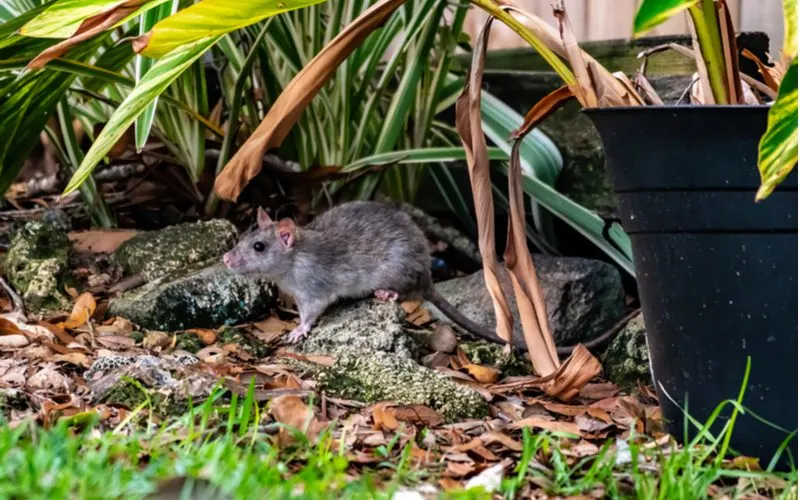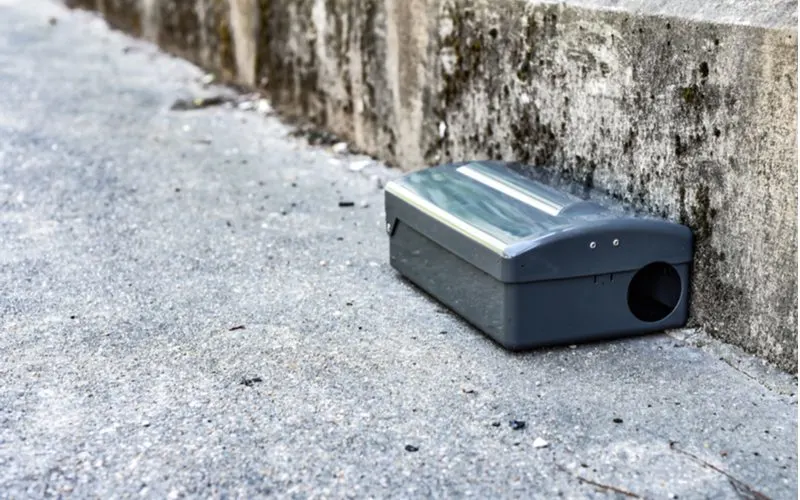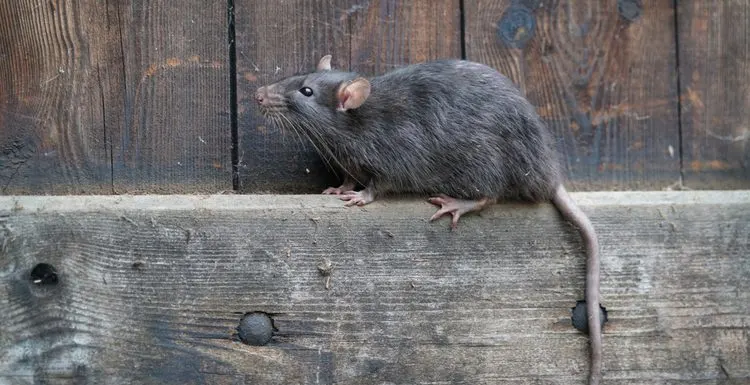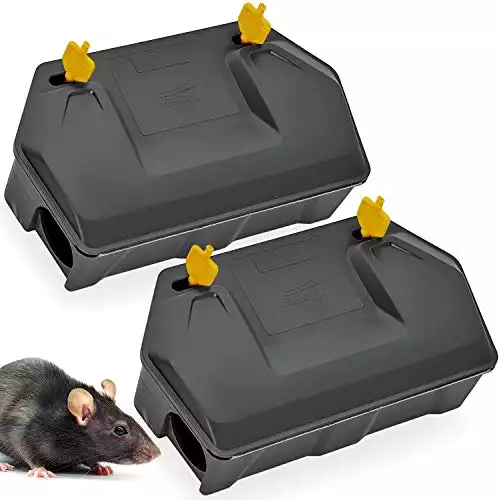Wondering how to get rid of rats? If so, we’re guessing that you have an infestation. But don’t worry—they’re easier to get rid of than you might think. Read on to learn about the steps to take and things to consider.
Rats can be a source of bacterial infections and other diseases, so removing or controlling them as swiftly as possible is essential.
We know the struggle, which is why we rounded up the best ways to get rid of them quickly.
Wondering How to Get Rid of Rats?
There are various ways to get rid of indoor and outdoor rats. To do so, you’ll need to follow the steps below (don’t skip any of them):
- Inspect your home for rats
- Identifying and sealing access areas, such as holes
- Thoroughly clean
- Use of chemical rodenticides
- Use rat traps
- Proper waste management: collection, storage, and disposal
- Eliminate the source of food
- Go natural
- Seeking professional assistance
How to Get Rid of Rats Inside a House

Irina Kozorog/Shutterstock
Rats inside a house is the most commonly encountered problem homeowners face. And it’s not pleasant. If you’ve seen a rat in your home, take the steps below immediately.
Step 1: Inspect Your Home for Rats
Start by conducting a thorough home inspection to find where the rats are coming from. Assess both the internal and external environment, because most rats sneak into your house in search of food.
As you inspect the exterior, pay close attention to cracks, gaps around vents, damaged drains, and your garage door for any obvious access point.
Step 2: Seal the Gaps
Rats typically enter your home through exterior holes and gaps. They don’t need a big access point, and can squeeze into small holes the size of a dime.
Sealing them using hardware cloth, steel wool, lath metal, or cement is a critical step in eradicating the problem.
Rats can also enter your house through damaged drains. Make sure you maintain and check the drains regularly.
For long-lasting results, fill the gaps and holes with drain covers and check them frequently.
Step 3: Thorough Cleaning
Rats love hiding. As you can imagine, one effective way to get rid of them is to poison and destroy their hideouts. Be sure to remove unnecessary materials such as old clothes and shoes that may provide shelter.
Clean up all clutter around your home and, if possible, move objects away from the wall.
Overall, ensure your house is clean. Keep all food and trash in closed bins; discard garbage as soon as possible. Clean any spills as quickly too.
Step 4: Use of Rodenticides
Rodenticides are poison baits used in areas inaccessible to children, pets, and other domestic animals.
We recommend the use of tamper-resistant bait stations, because they protect against accidental poisoning. They also keep the bait in place in while also keeping children and pets out.
Most laws require you to use tamper-resistant bait stations in areas accessible by children and pets. Only a single bait is required to provide lethal poisoning. Bait comes in the form of blocks, pellets, or meals.
We don’t recommend using pellets and any loose form of rodenticide because they risk incidental ingestion. The bait station with rodenticide doesn’t kill the rat; it only attracts the rat to the poison.
The rat usually consumes the poison and escapes to die outdoors. The only disadvantage is that the rat can die in an inaccessible room in your apartment, decompose and produce unwelcoming smells.
Step 5: Use Rat Traps
The EPA also advises against using certain rodenticides. Additionally, the California Ecosystems Protection Act prohibits the use of super-toxic poisons, also called second-generation anticoagulant rodenticides, to kill rodents.
For this reason, we suggest trapping rats rather than killing them. Strategically place your traps in high activity areas.
You’ll want to have enough traps with good bait such as apples, bananas, peanut butter, or unsalted seeds. Trapping is not more effective than bait; it only provides a good alternative if you don’t want to use poison.
If done properly trapping yields excellent results, especially for a small rat population. It also avoids the previously-mentioned foul odor you’ll encounter if a rat dies in your wall.
Step 6: Close Garbage Bins
Cover any waste containers or paper completely to limit access.
To reduce odor that emanates from the decomposition of the waste, keep it away from direct sunlight. Rats are usually attracted to such odors.
Step 7: Eliminate the Source of Food
Rats can obtain food from bins and old unusable materials or food residues. But, as with all organisms, food is a basic need. Rats are no exception. As such, controlling the food source is essential.
Store your food in sealed containers and dispose of food remnants appropriately. Clean any food spills immediately to prevent rats from being attracted to your home in the first place.
Step 8: Go Natural
For chemical-free households, there are some natural rat repellants to try. These include spreading black pepper, peppermint oil, cloves, or cayenne around the exterior of your home.
You can also try sprinkling irritants such as crushed pepper into the rat’s holes and entry points.
If you’ve ever accidentally inhaled pepper while cooking, you’ll know why this method is so effective. After all, rats smell with their noses, so they’ll turn the other way once they smell the pepper.
Step 9: Seek Professional Assistance
If the idea of capturing a rat or getting a disease scares you, a professional pest control expert if only a call away.
These companies can help in the identification of entry points, locate food caches and nesting areas.
How to Get Rid of Rats Outside a House

Karyn Honor/Shutterstock
Unfortunately, rats don’t only infest your home. They can also overwhelm your yard or garden. But don’t worry — we’ve rounded up a few steps to take to get rid of them here, too.
Step 1: Do Not Feed Wild Birds and Animals
Rats are typically attracted to a yard seeking food that’s fallen from wild animal feeders.
To get rid of such rats, ensure you stop feeding birds and wild animals. If you must, avoid spreading excess food, since the remains will attract rats.
Step 2: Keep Your Garden or Yard Tidy
Tidy gardens attract fewer rodents and other rats since they offer less cover and hideouts.
Keep your garden beds clean, keep your lawn short, and collect rubbish and vegetable remains, especially around the fences or garden beds.
Step 3: Move Things Around
Rats don’t like any disturbance to their territories and are afraid of new things. As a result, disrupting their hiding places and moving loose objects around your yard will keep them away.
Step 4: Block Any Access to Garden Buildings
Just as you’ve done indoors, sealing any holes on the walls, doors, and floors limits access to hiding places and food sources in a shed or outbuilding.
Step 5: Secure Your Compost Bin
You can secure your bin by making it unfriendly to rats. Install a chicken wire underneath to limit access. Turn your compost heap regularly as required.
Step 6: Buy a Pet
We don’t suggest getting a pet purely to catch rats, because the rats can carry diseases. However, dogs and cats can be good deterrents. Once a rat has been chased once, it’ll be scared to return to your yard.
Step 7: Eliminate Water Sources
Unlike mice, rats can’t survive without a source of water. If possible, remove potential water sources by securing drains and repairing or replacing dripping taps.
Step 8: Appropriate Control
First, you must identify their hideouts, including neighboring gardens, sheds, and garbage pits.
Rats breed very fast; so controlling an infestation early on is critical. To prevent them, you can use traps and poison to manage the rat population gradually.
Things to Consider

Oliver Hewett/Shutterstock
When dealing with a rate infestation, there are some things to consider. These include:
Things to Do
- If possible, move objects away from the wall
- Proper disposal of food residues
- Discard any old clothes and shoes that can provide shelter to the rats
- Close all water and food containers
- Close doors to prevent entry
- Seal any holes and assess them regularly
- Clean any food spillage in your house
Things Not to Do
- Limit the use of chemicals as it can harm your health
- Don’t keep rat poison with other household items; children can easily consume them
- Don’t keep traps in the reach of children; they can cause trauma
- If you feed birds, don’t spill excess food since the residues are likely to attract rats
- Don’t add food material to your compost pit
So, How Do You Get Rid of Rats?
You can eliminate rats from your house or yard in several ways. First, you must conduct a thorough inspection, control entry points, and eliminate obvious sources of food.
Other ways of getting rid of rats are to seek professional assistance, regular movement of hiding places, and use of poison. When in doubt, always call a pro — they’ll nip the problem in the bud before it spirals out of control.


